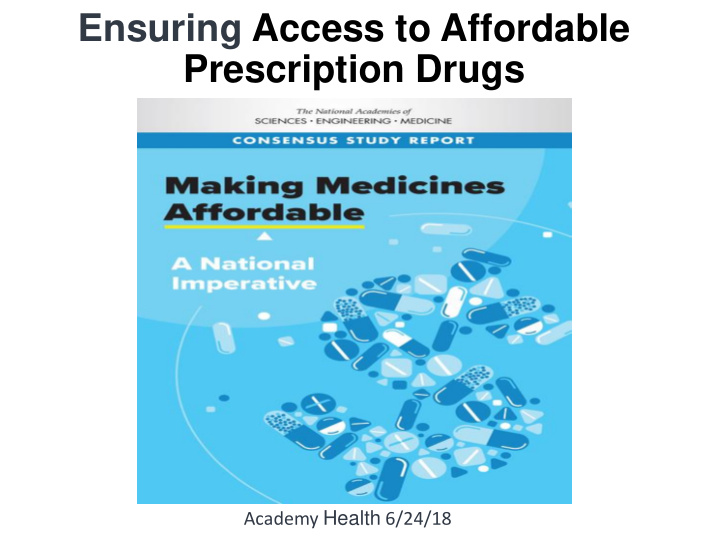



Ensuring Access to Affordable Prescription Drugs Academy Health 6/24/18
Figure 1 NASEM Committee Members • • Norman Augustine (Chair), Former, Eliseo Pérez-Stable, National Institutes of Lockheed Martin Corporation Health • • Jeff Bingaman, Former U.S. Senator, NM Charles Phelps, University of Rochester • • Rena Conti, University of Chicago Michael Rosenblatt, Flagship Pioneering • • Stacie Dusetzina, University of North Diane Rowland, Kaiser Family Foundation Carolina • Vinod Sahney, Northeastern University • Martha Gaines, University of Wisconsin Law • Peter Sands, Harvard Kennedy School and School Harvard Global Health Institute • Rebekah Gee, LA Department of Health • *Henri Termeer, Former, Genzyme Corporation • Victoria Hale, Oneworld Health and • Reed Tuckson, Tuckson Health Connections Medicines360 • • Alan Weil, Health Affairs and Project Hope Michelle Mello, Stanford Law School
Figure 2 Statement of Task • Examine patient access to affordable and effective therapies with emphasis on drug pricing, inflation in the cost of drugs, and insurance design Structural factors influencing drug pricing Policy factors related to insurance design and state prescribing laws Role of drug access programs and 340B Role of comparative effectiveness assessments How to prevent drug shortage and foster innovation
Figure 3 Over half of Americans report currently taking No … t 58% at least one prescription medicine 1 in 4 Americans say they take four or more prescription drugs 25% 12% 11% 9% + SOURCE: KFF Health Tracking Poll (conducted March 8-13, 2018)
Figure 4 Making Medicines Affordable Conclusion • Improving patient access to effective and affordable medicines is a national imperative not being adequately served by biopharmaceutical sector today. • Report’s major recommendations offer a path forward with associated implementation steps.
Figure 5 CHANGING FINANCIAL BENEFIT TRANSPARENCY IN DESIGN PRICING RECOMMENDATIONS GENERICS, LEVERAGING BIOSIMILARS & PURCHASING ORPHAN DRUGS POWER
Recommend
More recommend